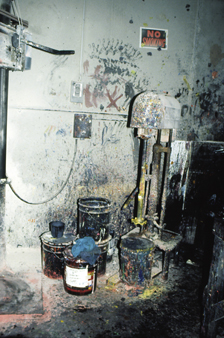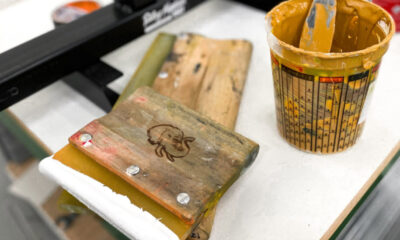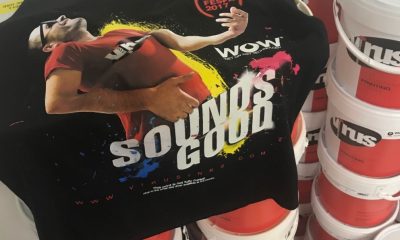Graphics Printing
Published
21 years agoon

When it comes to worker health and safety, graphics screen-printing operations face a long list of hazards against which workers must be protected. These hazards run the gamut, from potential repetitive-motion injuries and unsafe equipment operation to lifting dangers and chemical-exposure threats. With all the elements of production that pose obvious risks, it’s not surprising that many of us fail to realize menace in one of the essential components of the screen-printing process–the inks that we print. How safe are our inks?
When it comes to worker health and safety, graphics screen-printing operations face a long list of hazards against which workers must be protected. These hazards run the gamut, from potential repetitive-motion injuries and unsafe equipment operation to lifting dangers and chemical-exposure threats. With all the elements of production that pose obvious risks, it’s not surprising that many of us fail to realize menace in one of the essential components of the screen-printing process–the inks that we print. How safe are our inks? Hazards are associated with all industrial chemicals, including wash-up solvents, screen-cleaning and reclaiming chemicals, and inks. Perhaps because of their functions, we expect cleaning and reclaiming agents to contain aggressive chemicals. Consequently, we are more likely to put measures in place to protect worker health and safety when these materials are used. Unlike the other chemicals, however, inks are often overlooked as potential health risks. For example, as graphics screen printers, we quickly become familiar and comfortable with solvent-based inks. We know that solvent-based inks dry quickly if we happen to splash them on our skin or clothing. Because these inks are characterized by rapid evaporation of solvent and dry ink films create less irritation than wet ones, skin exposure to these inks causes us little or no discomfort. Although today’s inks are safer than those used in the past, their chemical components can trigger reactions when exposure is excessive. In terms of skin contact, the most common problems we face from exposure to solvent-based inks include dermatitis and skin sensitization (allergic reaction). With UV inks, risks from solvent exposure are far fewer, but a small percentage of users may have a severe allergic reaction to other chemicals in these formulations. As we’ll discuss later, we face additional risks from UV inks due to the way they are processed. The truth is that both ink systems must be treated with respect, and their use should be accompanied by good industrial hygiene and safe working practices. We must not become complacent in our working practices just because a material has never bothered us before or because we see that other workers are not using recommended safety gear. Forms of exposure Printers can be exposed to workplace chemicals in three primary ways: ingestion, skin/eye contact, and inhalation. (See "Dealing with Exposure " on page 55 for tips on how to handle accidental-exposure problems.) Ingestion In this form of exposure, the chemical is accidentally eaten or somehow swallowed. With inks, occasional splashes into the mouth are possible, but ingestion is normally not much of a problem for screen printers. The greatest risk for ink ingestion occurs in the screen-cleaning and reclaiming area, where high-pressure washers may cause the ink to splash unpredictably. Screenroom staff should wear face shields to prevent ink splashes from reaching their eyes and mouths. Other precautions against ingestion of inks and other chemicals include several common-sense practices. Always wash your hands before a snack or meal break to avoid accidental ingestion. Don’t store screen products in the same refrigerator as food and beverage items. It may seem clever to keep a tub of sensitive ink in the break-room fridge during the long, hot summer, but you’re just asking for trouble. This is also the reason why many operations prohibit food and beverage consumption at press side or on the production floor, a practice that is gaining widespread acceptance. Skin/eye contact The second means of chemical exposure is through the skin or eyes. Reactions to skin exposure occur primarily because of a breakdown in the natural oils in our skin. Solvents and harsh or aggressive cleaners can remove these oils, leaving our skin without a natural barrier. On top of this, solvents and screen washes we use during cleanup tend to liquefy, allowing them to penetrate our skin more easily. Once our skin oils have been removed, the exposed skin is susceptible to drying. Overly dry skin can even be irritated enough to show signs of dermatitis, such as redness, scaly appearance, itchiness, and puffiness. Repetition of the cycle of exposure-dryness-dermatitis can lead to skin sensitization, which is a type of allergic reaction. When someone has become sensitized to a chemical, direct contact with the offending chemical is not necessary in order for dermatitis to recur. Exposure to small amounts of ink, solvent, or even chemical vapors in the air can trigger the allergic reaction so that uncomfortable symptoms may return. Dermatitis and sensitization may not happen immediately upon exposure; in fact, they typically do not show up until after years of repeated exposure. During my years in the screen-printing industry, I have personally known three people who eventually became sensitized to certain materials. The first was a woman who became sensitized to film-developer chemistry after years of repeated exposure through tray developing of camera film; she gets contact dermatitis from the developers, so now she simply does not enter camera darkrooms. The second was the owner of a screen shop who developed sensitivity to specific UV; eventually he had to just stay out of the UV building of his factory. The third was a color matcher who developed multiple sensitivities to numerous and solvents; the problem was resolved when she was promoted to another department and was no longer in direct contact with and solvents. The other form of direct physical contact to avoid is eye exposure, which usually results from accidental splashes. The most effective prevention is to mandate the use of shop glasses. In areas where splashes are more likely (such as screen cleaning), face shields may be necessary. Inhalation This is a very common means of exposure. Basically, if you can smell it, then you are inhaling it! Excessive inhalation of chemical vapors can contribute to nausea, headaches, and even sickness. Screen shops must have sufficient ventilation in order to reduce staff exposure to chemical and solvent vapors. Just keep in mind that most solvents used in screen printing have vapors that are heavier than air. This means that vapor extraction should be at floor level, rather than at the ceiling. Extraction from ceiling level can actually increase overall exposure to dangerous vapor as it pulls solvent fumes from ground level up through the "breathing zone" toward the ventilator. If staff are overcome by fumes, or even if they begin to feel light-headed or dizzy, remove them to fresh air as quickly as possible. Medical attention may be necessary in some cases. Incidentally, just because something smells bad does not mean that it is necessarily bad for you. (Remember Grandma’s cooked cabbage?) Any change in odor or noticeable presence of a new odor may be automatically perceived as "bad" when it only signifies "different." Whenever your shop converts to a new ink system or screen wash, be aware that it takes most people a week or two to get used to the change in odor. Some and screen-printing chemicals contain re-odorants to minimize unpleasant smells (apart from those used in scratch-and-sniff printing). The more common examples of re-odorants include vanilla and spearmint, but cinnamon, pine, green apple, citrus, and several others are also used. The advantage of re-odorants is that they can minimize strong odors. The disadvantage is that pleasant smells may convince users that ventilation is unnecessary. Be mindful that the presence of re-odorants is not an excuse for inadequate ventilation. With UV, the curing process itself creates another inhalation hazard. UV-curing units are designed to maximize UV output in order to cure printed efficiently. But that UV energy can also cause oxygen in the air around the curing zone to form ozone (O3) molecules, which have three atoms of oxygen instead of the two usually found in natural oxygen. Ozone in the upper atmosphere around the planet is a good thing, as it shields us from excessive exposure to UV from the sun. But ozone in our breathing zone is not such a good thing. High concentrations of ground-level ozone can cause shortness of breath, coughing, wheezing, headaches, nausea, and eye and throat irritation. Ozone can severely restrict breathing in people who suffer from emphysema, bronchitis, pneumonia, asthma, or colds. Studies show that healthy adults also experience decreased function of their lungs when exposed to ozone. Exposure risks only worsen when someone is exposed to ozone while engaged in a physical activity that increases the breathing rate, causing the individual to inhale more ozone than under normal circumstances. We can deal with potential ozone problems in a couple of ways. The first and best method is to ensure that there is adequate ventilation and extraction of air from the curing area of the UV dryer. Curing units typically come with ventilation fans. But depending on how and where we exhaust the air from our facilities, it may be necessary to install supplemental extraction fans in the ventilation system. The other solution is to actually remove the oxygen from the curing zone of the dryer. In certain specialty applications, UV are cured in dryers that replace air in the curing chamber with nitrogen gas. Since there is no oxygen exposure to UV energy, no ozone is generated. Such curing systems were most popular in the 1970s and early ’80s and aren’t often seen today. Their main drawback is that they required a continuous nitrogen supply, which increases a shop’s operating expenses. Protecting against ink hazards Whether we use solvent-based or UV-curable, chances are good that we will need to clean our squeegees and screens when a job is finished. Cleanup is one of the times when we face the greatest risk of skin exposure to chemicals, since both and screen wash-up materials can be in contact with our skin for long periods. If our cleaners contain highly evaporative solvents and we lean over mesh or press components to clean them, we also dramatically increase our risk of exposure through inhalation. Proper ventilation is the only real solution to reduce the hazards of inhalation. And to prevent the problems that come with prolonged skin contact, use of barrier creams and gloves is highly recommended. Barrier creams work best in conjunction with gloves, but even barrier cream alone is better than no skin protection at all. Place a tube of barrier cream at each press, as well as in the color-matching, color-blending, and screen-processing departments. Selection of gloves can become an issue in many print shops. Some people prefer tight "surgical-style" latex gloves that can be worn during many shop operations. Other staff may prefer heavier Nitrile gloves during the cleanup of press equipment and screens. Still others (such as screen-reclaiming staff) may require full-length, heavy-duty gloves that protect the entire arm. Today, more shops are opting for 0.4-mm-thick Nitrile gloves. This is due in part to the number of people who are allergic to latex gloves and/or the powders used in them, and also because thin latex gloves are more prone to leakage. Gloves come in many styles, and don’t assume that one style of glove will work for everyone on the shop floor. Employees should have the opportunity to test several glove styles and to select the ones that are most appropriate for their work duties. Staff members are much more likely to wear gloves that are functional and comfortable. For additional protection against physical contact with ink and other chemicals, various types of impervious clothing can be employed. Press operators should wear aprons and shoes that are resistant to printing. Disposable Tyvek garments are common in most industrial screen-printing operations and include items such as lab coats, aprons, zip-up suits, shoe coverings, head or hair coverings, facial masks, and other specialty garments. Production and safety requirements for each printing plant will vary, so staff should evaluate conditions to determine appropriate protective clothing. One advantage of the disposable clothing is that it protects more expensive clothing from damage. Even with the use of gloves, we may still occasionally get ink on our skin. At such times, it may seem easy to reach for a solvent-soaked rag to clean ourselves up, but that is an unwise practice. It is much more safe and effective to go to the sink and wash up with soap and water or use a special hand cleaner designed for printers or mechanics. Shop glasses are another key protective item that should be worn throughout the operation. These should be designed to protect against accidental splashes. For shops that that do a great deal of UV printing, glasses are also offered with UV barriers to protect the eyes. Speaking of UV, let’s consider a final hazard that occurs infrequently, but still deserves mention. It concerns the possibility of getting "sunburned" from stray UV light escaping from UV-curing units. In some cases, UV light escapes due to inadequate shielding around the curing chamber. In rarer circumstances, the,UV light may be reflected by glossy substrates (e.g., polyester or polycarbonate sheets) and can cause a bit of exposure to staff sitting at belt level at the end of the UV dryer. Protecting against this problem is fairly simple. First, set up and use the shields that were included on the dryer by its manufacturer. If you feel too much light is still escaping from the exit side of the curing chamber, you might try adhering a 6-in.-wide piece of ruby masking film to the bottom of the shield so that the film actually touches the dryer belt. The masking-film "curtain" will easily lift up to allow the cured sheet to pass underneath without interference. If excessive UV-light emission is still a problem, you can conduct a simple test. Turn out the room lights while the curing unit is on, and see where the visible light shines. Even though UV light is invisible, it will still follow the same path as visible light. Place UV blocking curtains where needed to prevent employee exposure to the UV light. As an extra precaution, some printers and screenmakers also wear a bit of sun-blocking cream–just in case. Conclusion Companies are required to provide safe working environments and adequate protection from chemicals. But in the end, we must each make our own decisions about maintaining good industrial hygiene. Managers and key staff should be models of good industrial hygiene practices and behaviors. For example, if production employees are required to wear safety glasses, then managers and visitors should also wear them while on the shop floor. The most important thing we can do is make handling instructions and precautions very clear. Three rules should be the foundation of our instructions: Don’t eat it! Don’t breathe it! Don’t leave wet ink on your skin! Contact your ink supplier when you have questions about specific ink formulations and their hazards or require additional information about ink-related health and safety issues.

Subscribe

Magazine
Get the most important news
and business ideas from Screenprinting Magazine.
Most Popular
-

 Art, Ad, or Alchemy1 month ago
Art, Ad, or Alchemy1 month agoF&I Printing Is Everywhere!
-

 Case Studies1 month ago
Case Studies1 month agoHigh-Density Inks Help Specialty Printing Take Center Stage
-

 Andy MacDougall1 month ago
Andy MacDougall1 month agoFunctional and Industrial Printing is EVERYWHERE!
-

 Columns2 weeks ago
Columns2 weeks ago8 Marketing Mistakes Not to Make When Promoting Your Screen Printing Services Online
-

 Editor's Note2 weeks ago
Editor's Note2 weeks agoLivin’ the High Life
-

 Thomas Trimingham2 months ago
Thomas Trimingham2 months ago“Magic” Marketing for Screen Printing Shops
-

 Marshall Atkinson2 weeks ago
Marshall Atkinson2 weeks agoHow to Create a Winning Culture in Your Screen-Printing Business
-

 News & Trends1 month ago
News & Trends1 month agoWhat Are ZALPHAS and How Can You Serve Them in Your Print Business?





